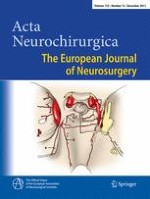Published in:

01-12-2011 | Clinical Article
Hardware-related infections after deep brain stimulation surgery: review of incidence, severity and management in 212 single-center procedures in the first year after implantation
Authors:
Massimo Piacentino, Manuela Pilleri, Luigi Bartolomei
Published in:
Acta Neurochirurgica
|
Issue 12/2011
Login to get access
Abstract
Background
Device-related infection is a common occurrence after deep brain stimulation (DBS) surgery, and may result in additional interventions and a loss of efficacy of therapy. This retrospective review aimed to evaluate the incidence, severity and management of device-related infections in 212 DBS procedures performed in our institute.
Methods
Data on 106 patients, in whom 212 DBS procedures were performed between 2001 and 2011 at our institute by a single neurosurgeon (M.P.), were reviewed to assess the incidence, severity, management and clinical characteristics of infections in the first year after the implantation of a DBS system.
Results
Infections occurred in 8.5% of patients and 4.2% of procedures. Of the nine infections, eight involved the neurostimulator and extensions, and one the whole system. The infections occurred 30.7 days after implantation: 7 within 30 days and 2 within 6 months. Infected and uninfected patients were comparable in terms of age, sex, indication for DBS implantation and neurostimulator location. In eight cases, the system components involved were removed and re-implanted after 3 months, while in one case the complete hardware was removed and not re-implanted.
Conclusion
The overall incidence of postoperative infections after DBS system implantation was 4.2%; this rate decreased over time. All infections required further surgery. Correct and timely management of partial infections may result in successful salvage of part of the system.





